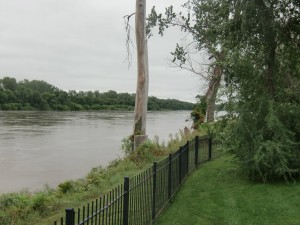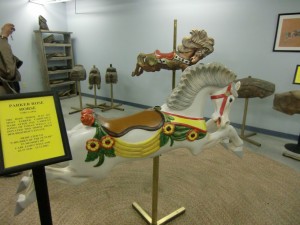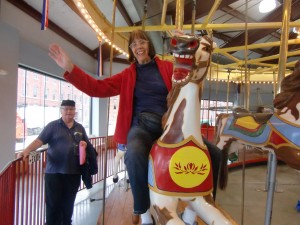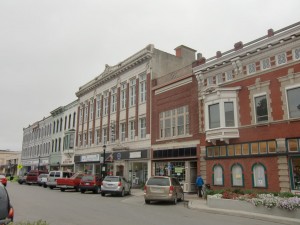ROAMING AROUND KANSAS – A BEGINNING AT LEAVENWORTH
ROAMING AROUND KANSAS
This is the first in a series of articles about touring the state of Kansas
A BEGINNING AT LEAVENWORTH
By Charles N. Stevens
Photos by Dolores Seidman
The first question people asked me when I told them we were going to take a tour of Kansas was “Why in the world would anyone go to Kansas unless he knew someone there?” My answer was always positive, that there was plenty to see and do in Kansas if you just looked.
After an uneventful flight from Los Angeles, we landed at the Kansas City, Missouri Airport and were soon whisked away by shuttle to the Drury Hotel where we spent the night.
The following morning is gray and drizzly, the streets damp with mist. A steady wind is strong enough to ripple a large American flag on a hilltop not far from our window. After a wonderful breakfast of eggs, potatoes, sausage and biscuits and gravy, we leave for our first day of the tour.
Heading out on I-29, we’re impressed with how green the trees, shrubs and grasses are compared to the dead summer look of southern California. We turn off the interstate highway then cross over the Missouri River into Kansas on a country road. We pass beige stands of corn and fields where the corn has been cut down to stubble. White farm houses alternate with forests and undulating hills. This part of the state is not as flat as its western half. Looking out at country so different from what we see in our everyday suburban lives is stimulating and, in a curious way, relaxing.
Our first stop is in Leavenworth, birthplace of the carousel, at the C. W. Parker Carousel Museum. As the museum is not yet open, we walk in a nearby park that looks out on the fast-flowing Missouri River, gray under an overcast sky. Here and there, tree trunks and branches ride in the river’s swift current. The park occupies the area that used to be the Port of Leavenworth, very active when riverboats once docked here. Having been chilled by our walk, we’re glad to finally enter the warmth of the museum. After a film about the care and artistry of carving carousel horses an enthusiastic young woman takes us through a vast collection of carousel horses, old and new, complete and incomplete. I didn’t know that there was so much to learn about carousels. The climax of our tour was a ride on the museum’s own fully operational carousel. It was fun to listen to the calliope-like music as we whirled around, the horses bobbing up and down, the breeze of its motion on our faces.
It’s still chilly at noon as we wander the streets of downtown Leavenworth, enjoying the old but quaint buildings of the town and looking for a place for lunch. Finally Dolores and I duck into the Family Bistro, a very small café, for a warm bowl of delicious pasta fazool soup and a chicken salad sandwich. Continuing our walk after lunch, we head for the Corner Drug Store, a wonderful relic of the past that still maintains a soda fountain and lunch counter. The whole town, except for the cars, is a peek back into former times.
On our way again, we pass the extensive grounds of Fort Leavenworth Army Base and then the stark stone presence of the Leavenworth Prison where some of our most notorious prisoners are held. The Greek-like, white-columned center rises up into the gloomy overcast sky while arched brick walls flank it on either side, the whole complex fenced and strung with razor wire. Our bus moves on to the Veterans hospital and the grassy acres where some of the original military brick homes still stand, most of them too decrepit to live in, paint peeling and wood sagging. We pass rows of white crosses in the military cemetery and great lawns where hundreds of Canada geese graze. The six-story hospital contains 447 beds.
Our next venture is checking into our hotel right in the middle of active Fort Leavenworth. As it is September 11th, the Army guards at the gate are thoroughly inspecting every vehicle that enters, making people get out of their cars while the cars are searched. This is a slow procedure, so the line of cars, buses and trucks is quite long. As we are in a bus, they simply check our IDs, open the baggage compartment, and we are on our way to the hotel. It seems strange to be on an army base where so many men walk around in gray camouflage fatigues. Our IHG Army Hotel is being converted into a Holiday Inn Express as we move in.
Once settled in our rooms, we leave for another short bus trip to the old Leavenworth Railroad Station. At one time very busy, it is not used for passengers now, the only clue that we are near a railroad being the roar of long freight trains as they thunder past. The station is a magnificent structure, well worth seeing. Inside one of the former waiting rooms, women dressed in the costumes of the famous Harvey Girls, black uniforms with short white aprons, serve us dinner. As Fred Harvey, developer of the Harvey Houses along the Santa Fe Railroad, once lived in Leavenworth, the dinner was most appropriate. His grand home still stands in Leavenworth, but is now undergoing extensive remodeling. While we dine on chicken breast with wild rice and green beans, the Possum Holler Barbershop Quartet, dressed in striped prison uniforms, entertains us with a few songs, their harmony resonating in the spacious room. I assumed their attire was in reference to the famous Leavenworth Prison.
Soon after we return to our hotel, we’re off again for a tour of Fort Leavenworth, led by , a former Army officer who describes the sights as our bus rolls by. The fort is like a great park with lawns and trees, old but grand officers’ houses among them. He informs us that the fort is primarily a military college for officers to keep up with their skills and acquire new ones.
Having had enough for one day, we return to our hotel for well-earned rest.

"We walk in a nearby park that looks out on the fast- flowing Missouri River, gray under an overcast sky."

"...an enthusiastic young woman takes us through a vast collection of carousel horses, old and new, complete and incomplete."

"It was fun to listen to the calliope-like music as we whirled around, the horses bobbing up and down, the breeze of its motion on our faces."

"The whole town (of Leavenworth), except for the cars, is a peek back into former times."
MONTEREY PARK AUTHOR PUBLISHES 4th BOOK – Seeking More of the Sky: Growing Up in the l930’s:
Charles “Norm” Stevens, a 43 year resident of Monterey Park has recently published his 4th book: Seeking More of the Sky: Growing Up in the l930’s. This is the story of a young boy growing up in Inglewood, California in the l930’s. This was a time during the depression when unemployment was affecting many and the banks were closed, while the clouds of war were gathering in Europe. But he was lucky enough to be raised in a loving family, the power of that love reflected throughout his stories.
Stevens is the author of three previous books about his experiences during WWII:
An Innocent at Polebrook: A Memoir of an 8th Air Force Bombardier (Story of his 34 bombing missions from his base at Polebrook, England over Germany and France)
The Innocent Cadet: Becoming A World War II Bombardier (A prequel to the first, telling of his training in the U.S. before going overseas into combat.)
Back from Combat: A WWII Bombardier Faces His Military Future from Combat: (This book details the time from when he returned from combat in England until the end of the war.)
He is known to the readers of The Citizen’s Voice as the author of Travel Log Articles including “Cruising the Rhine and Mosel”,” Best of the West”, “In Search of Snow” , “From Paris to Normandy on the Seine”, and “Exploring New York”. He is retired, having taught for 32 years, primarily in the Montebello Unified School District.
Those interested in purchasing an autographed copy of any of his books, may contact the author at 323-721-8230 or Normstevens24@gmail.com.
Meet the Author at the Monterey Park Bruggemeyer Library
Located at 318 S. Ramona Avenue, Monterey Park, CA 91754
Charles “Norm” Stevens talks about his new book, “Seeking More of the Sky: Growing Up in the 1930s,” on Sunday, March 8 at 2 p.m. in the Friends Room. Stevens, a WWII veteran and the author of several autobiographical accounts of his experiences as a bombardier aboard a B-17 Flying Fortress will read from his book and share his stories about growing up in Los Angeles during the Depression while the clouds of war were gathering in Europe.



